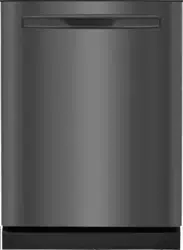Documents: Go to download!
User Manual
- Owner's manual - (English)
- Wiring Diagram - (English)
- Installation Instructions - (English)
- Product Specifications Sheet - (English)
- Quick Start Guide - (English)
- Energy Guide - (English)
- FEATURES AT A GLANCE
- OPERATING INSTRUCTIONS
- PREPARING AND LOADING DISHES
- DISHWASHER DISPENSER AND DETERGENTS
- FACTORS AFFECTING PERFORMANCE
- CARE AND CLEANING
- BEFORE YOU CALL
Table of contents
User manual Dishwasher
FEATURES AT A GLANCE
Your dishwasher cleans by spraying a mixture of hot water and detergent through the spray arms against soiled surfaces. First, the dishwasher fills with water covering the filter area. Water is then pumped through the spray arms. Soil particles go across the filter and down the drain as the water is pumped out. This series of steps are repeated as needed. The number of water fills vary with the cycle being used.

Wash Cycle Selections: Cycle times are approximate and will vary with options selected. Hot water is necessary to activate dishwasher detergent and melt fatty food soils. An automatic sensor will check the incoming water temperature and, if it is not hot enough, the cycle will be lengthened for automatic water heating in the main wash and final rinse of all cycles. This happens even when HI-TEMP WASH option has not been selected. When HI-TEMP WASH is selected, an even higher temperature will be reached to handle heavier soil loads.
NOTE Lights on the console will remain on once the door is shut and wash cycle begins. If it is preferred to have the lights turn off while cycle is running see Console Lights section for instructions.
Option Selections (available on select Models)
Hi-Temp Wash Option
When HI-TEMP WASH option is selected, the dishwasher heats water in the main wash to approximately 140° F (60° C).
This increase in water temperature helps the dishwasher detergent remove food grease and soil from dishes more effectively and aids in drying. HI-TEMP WASH option is available on POWER PLUS, NORMAL WASH and TOP RACK cycles. HI-TEMP WASH is automatically provided when the POWER PLUS cycle is selected.
When HI-TEMP WASH option is selected, the indicator light will come on and remain on until end of cycle. To turn off the HI-TEMP WASH option, press HI-TEMP WASH a second time. The indicator light will turn off.
OPERATING INSTRUCTIONS
Heat Dry/Air Dry
Use of the HEAT DRY option, especially in combination with use of rinse agent, will enhance drying. If AIR DRY is selected the heater will be de-activated during the drying phase of the selected wash cycle. This will slightly lower the energy use but will increase the likelihood that the dishware will not dry completely.
MaxBoost Dry TM
When MaxBoost DryTM option is selected, the dishwasher extends drying time by approximately 20 minutes. The MaxBoost DryTMoption can be used with all cycles except CHINA CRYSTAL, ENERGY SAVER and RINSE ONLY. For best drying performance, also apply an increased wash temperature by selecting HI-TEMP WASH or even better, the SANITIZE option.
The energy required to use the MaxBoost DryTM option costs pennies per cycle. You may choose not to select the MaxBoost DryTM option; however you may have items in your dish load that will not be completely dry at the end of the cycle.
Sanitize Option
To sanitize your dishes and glassware, select the SANITIZE option. When selected, the indicator light will come on and remain on until the end of cycle. The water temperature in the final rinse will be raised to 156° F (69° C). This option is available in POWER PLUS, NORMAL WASH and TOP RACK Cycles. Only these sanitization cycles have been designed to meet NSF requirements.
The cycle time will be extended until the proper water temperature is reached. Washing action will continue during the water heating delay. For best results, the incoming water temperature should be at least 120° F (49° C).
The sanitize criteria may not be satisfied if there is an interruption of the cycle, power failure or if the incoming water temperature is below 120° F (49° C).
To turn off the SANITIZE option, press SANITIZE a second time. The indicator light will turn off.
Favorite Cycle
The FAVORITE CYCLE option allows you to program your preferred cycle and options into one button. Once Programmed, simply select FAVORITE CYCLE and then select START/ CANCEL.
To Program the FAVORITE CYCLE:
1. Select your preferred cycle and options
2. Press FAVORITE CYCLE for 3 seconds.
The display will flash for 2 seconds indicating the FAVORITE CYCLE option has been programmed. To change the FAVORITE CYCLE option simply repeat steps one and two above.
Delay Start
The DELAY START option allows you to automatically delay starting your dishwasher 1-24 hours.
To start the DELAY START option, press DELAY START until the desired delay time shows in the STATUS window. A light will come on indicating the delay has been set and will remain on until cycle starts. Press the START/ CANCEL pad to start the delay option. If the delay option is interrupted, the START/CANCEL pad will have to be pressed again to return to delay option.
To cancel the DELAY START option and to begin the selected cycle before the delay period is over, press and hold START/ CANCEL pad for 3 seconds.
To Cancel a Cycle
You can cancel a cycle anytime during the cycle. Press and hold the START/CANCEL pad for 3 seconds. The light above the cycle and option selected will go out, and the START/ CANCEL light will remain illuminated, the dishwasher will start a 90 second drain. At the end of the drain, select the next desired cycle.
Child Lock Controls
To prevent children from accidently changing the dishwasher cycle or starting the dishwasher, to lock the dishwasher controls press and hold DELAY START for 3 seconds. An indicator light on the lock graphic pad will illuminate when the controls are locked and no new selections can be made until the lock is released. To unlock the controls, press DELAY START again for 3 seconds, and the indicator light will go out.
Status Indicator Lights
The console lights provide information about the cycle selection and current status. During operation, while the door is closed, these lights will remain on. At the completion of the cycle, the clean light will come on. The sanitization light will also come on if that option was selected and sanitization was achieved during the wash cycle.
Status Window
The STATUS window, available on some models, indicates the following activity:
1H-24H............. Number of delay start hours. The last hour will count down in minutes.
MINUTES.......... Number of minutes left in cycle (1-199).
CLOSE DOOR.... Close door will scroll one time in the status window.
In the unlikely event that the dishwasher malfunctions, displays the error code “Uo”, or gives poor performance you can call the Frigidaire Customer Care Center at 1-800-944-9044. They will be able to provide assistance in troubleshooting the problem and/or locating an authorized service technician, if needed.
Console Lights
If it is desired to have the console lights remain off while running, perform the following operation: Prior to starting a cycle, press and hold POWER PLUS and RINSE ONLY simultaneously for approximately 8 seconds until the corresponding lights flash. This will turn the console lights off during cycle operation. Simply repeat this operation to revert back to the previous setting.
Overlay

The DishSenseTM Technology checks the soil level on your dishes in the POWER PLUS, NORMAL WASH TOP RACK and ENERGY SAVER cycles. In response, automatic cycle adjustments are made to assure the dishware gets clean - with less food the cycle gets shorter. Cycle time will also vary based on the options selected and the incoming water temperature. Not all cycles available on all models.
Cycle and Option Chart

* Cycle uses Soil Sensing feature to determine best Wash performance.
PREPARING AND LOADING DISHES
Dish Preparation
Scrape away large pieces of food, bones, pits, toothpicks, etc. The continuously filtered wash fluid will remove remaining food particles. Burned-on foods should be loosened before loading. Empty liquids from glasses and cups.
Foods such as mustard, mayonnaise, vinegar, lemon juice and tomato based products may cause discoloration of stainless steel and plastics if allowed to sit for a long period of time. Unless the dishwasher is to be operated at once, it is best to pre-rinse or use the RINSE ONLY cycle to rinse off these food soils.
• Load racks so that large items do not prevent the detergent dispenser from opening.
• Check manufacturer’s recommendations before washing items in question.
• If the dishwasher drains into a Food Disposer, be sure disposer is completely empty before starting dishwasher.
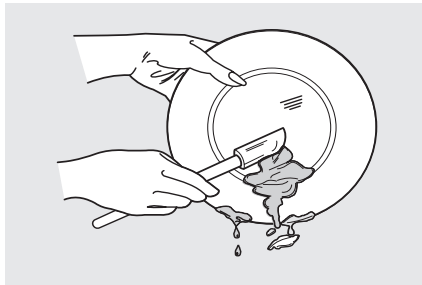
Loading the Top Rack
Features and appearance of racks and silverware basket as shown may vary from your model.
The upper rack is designed for flexibility in loading a wide variety of items including cups, glasses, stemware, small plates, bowls, etc.
Load glasses in top rack only. Damage may occur if placed in bottom rack.
Load plastic items in top rack only. Melting may occur if placed in bottom rack.
Load items with open ends facing down for better cleaning and draining.
Damage may occur if delicate items touch each other during dishwasher operation.
Long-handled knives and utensils can be placed in top rack.
Be sure nothing protrudes through the bottom of the rack to block rotation of middle spray arm.
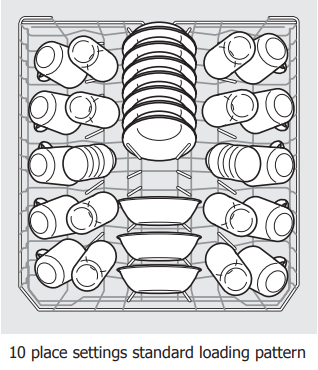
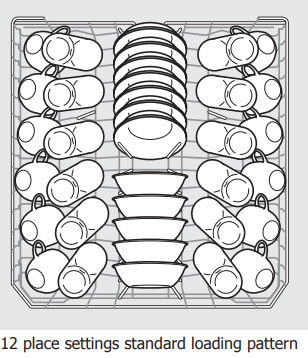
Some models have a fold-down cup shelf or a cup shelf/stemware holder. They can be used to load two levels of cups, juice glasses, and other short items. Stagger items on upper level so that water can reach all inside surfaces. Fold up to load tall glasses.
Upper Rack
The UPPER RACK cycle directs cleaning only to items in the upper rack and can be used to wash a wide assortment of items. It is useful for washing partial loads - especially when the upper rack fills up with glasses and the lower rack is still empty.
STEMWARE HOLDER/ CUPSHELF not available on all models.

Adjustable Upper Rack
To raise the upper rack, refer to the figure below.
Press the lever toward the center of the rack and pull straight up on the rack.
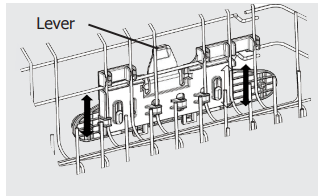
To lower the upper rack, press the lever and push down on the rack.
Bowl Tines
The bowl times offer the ultimate in flexibility. When closed, load with saucers or small dishes. Open halfway and it is perfect for small casserole dishes. Open completely for those hard to fit items. As you load your dishwasher, you will find many other ways to use this unique feature.

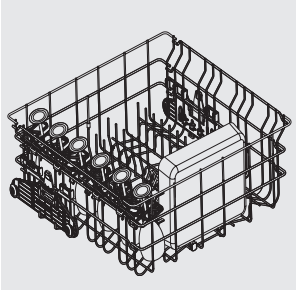

Loading the Bottom Rack
Features and appearance of racks and silverware basket as shown may vary from your model.
The lower rack is best for plates, saucers, bowls, and cookware. Large items should be placed along the edge so they do not block the spray arm rotation. For best results, place bowls, casseroles, and sauce pans with soiled surface facing down and toward the center. Tilt slightly for better drainage.
Spin the middle spray arm to make sure that tall items do not block the rotation
Be sure pan handles do not protrude through the bottom of the rack and block the lower spray arm rotation.
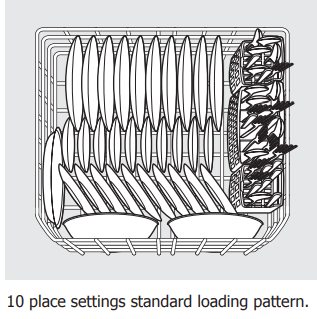
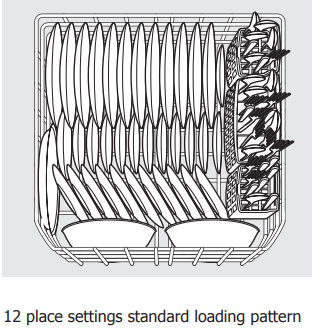
Fold-down Tines
The fold-down tines in the lower rack make easy loading for those extra large and hard-tofit items. The tines may be left up for normal use or folded down for more flexible loading. Fold down for more space to load large pots or pans.
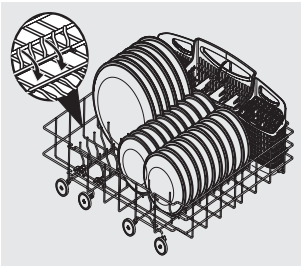
Loading the Silverware Basket
Features and appearance of racks and silverware basket as shown may vary from your model.
Load the silverware basket while it is in the bottom rack or take the basket out for loading on a counter or table.
For baskets with lids, small items like baby bottle caps, jar lids, corn cob holders, etc., can be placed in a covered section to hold them in place.
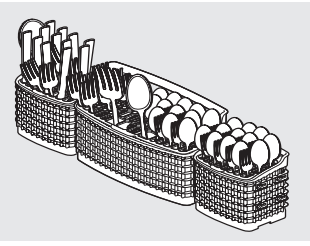
Use suggested loading patterns, as shown, to increase washability of the silverware.
Be sure nothing protrudes through bottom of basket or rack to block the spray arm.
To avoid damaging the silver finish do not mix silver and stainless.
When covers are up, mix items in each section of the basket with some pointing up and some down to avoid nesting. Water spray cannot reach nested items.
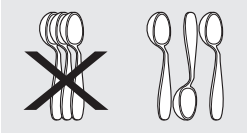
Adding a Dish
To add or remove items after wash cycle starts:
- Unlatch door and wait a few seconds until wash action stops before opening.
- Add the item, move the door to a nearclosed position, and wait a few seconds while the cold air slowly expands inside the dishwasher.
- Press the START/CANCEL pad then close the door firmly within 4 seconds to resume.
DISHWASHER DISPENSER AND DETERGENTS
Filing the Detergent Dispenser
The detergent dispenser has two detergent cups. The smaller one is for addition to the pre-wash and the larger is for release to the main wash.
- Use only fresh automatic dishwashing detergent. Other detergents may cause oversudsing.
- When using automatic dishwashing detergent tablets or packets, use only one tablet or packet, place in the main wash cup and close.
- Add detergent just before starting cycle.
- Store detergent in a cool, dry location and discard any that becomes moist or caked.
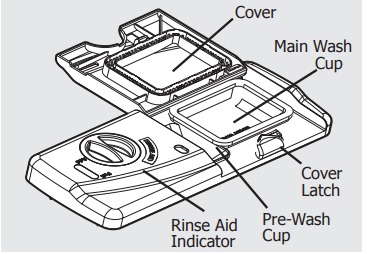
If the cover is closed on the Main Wash Cup open by pressing the Cover Latch.
How much Detergent to use
The amount of detergent to use depends on the water hardness. Water hardness is measured in grains per gallon. Using too little detergent can result in poor cleaning and hard water filming or spotting. Using too much detergent in soft water can cause etching to some glassware which is surface damage that appears like a film but cannot be wiped off. Your local water company, water softener company or county extension agent can tell you the water hardness in your area.
CAUTION The use of industrial grade detergent can damage the heating coil and other parts of the dishwasher leading to damage to the unit and surrounding property. Use only household grade automatic dishwasher detergents.
Detergent Usage Chart
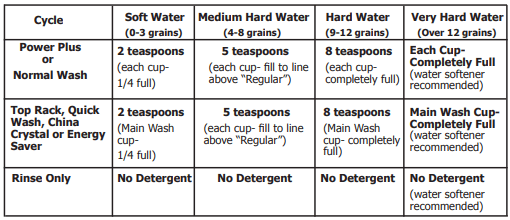
As a rule, use 1 teaspoon for each grain above 12. For very hard water, detergent alone may not be enough and then a water softener is recommended to improve water quality and dishwashing performance. However, when - using automatic dishwashing detergent tablets or packets simply place one in the main wash cup.
FACTORS AFFECTING PERFORMANCE
Rinse Aid
Rinse aid greatly improves drying and reduces water spots. With it water “sheets” off dishes rather than forming water droplets that cling and leave spots.
A dispenser, located next to the detergent cup, automatically releases a measured amount of rinse aid during the last rinse. If spotting and poor drying are problems, increase the amount of rinse aid dispensed by rotating the dial to a higher number. The dial is located under the dispenser cap. The indicator will be dark when full and will show clear when it is time to refill.
To add liquid rinse aid, turn dispense cap 1/4 turn counterclockwise and lift out. Pour in rinse aid until liquid touches the indicated fill level Replace cap.
Do not overfill since this can cause oversudsing. Wipe up any spills with a damp cloth.
The dispenser holds enough for 35 to 140 washes, depending on the dial setting.

Water Pressure
The hot water line to dishwasher must provide water pressure between 20 and 120 psi.
Low Water pressure may occur when laundry or showers are in operation. If you experience poor wash performance you may need to wait until water use is reduced before starting dishwasher.
Water Temperature
Hot water is needed for best dishwashing and drying results. Water entering dishwasher should be at least 120° F (49° C) to give satisfactory results.
To check water temperature entering dishwasher:
- Turn on hot water faucet nearest dishwasher for several minutes to clear cool water from pipes.
- Hold a candy or meat thermometer in the water stream to check the temperature.
- If temperature is below 120° F (49° C), have a qualified person raise the hot water heater thermostat setting.
IMPORTANT Before starting a cycle, run hot water to clear cool water from pipe.
The HEAT DRY option in combination with rinse aid will enhance drying performance. The energy required to use the HEAT DRY option costs pennies per cycle. You may choose not to select the HEAT DRY option; however you will have items in your dish load that will not be completely dry at the end of the cycle.
CARE AND CLEANING

To empty the glass trap:
- Grasp the glass trap’s handle and rotate it 900 clockwise while pressing down on the center of the wash arm.
- Grab the spray arm in the center and lift the spray arm and glass trap assembly up and out from the dishwasher.
- Tip the assembly over an appropriate container and tap it to empty the glass trap. OR, separate the glass trap - pull the glass trap handle toward you, then up, then further toward you to slide it away from the rest of the assembly; empty it into an appropriate container; then slide the glass trap back into the assembly.
- Place the assembly back into position, press down on the arm at the center and rotate the glass trap handle 900 counterclockwise being sure the glass trap ends in the orientation shown in the image above. To avoid damage to your unit make sure the spray arm and glass trap are fully snapped in place.
Outer Door - Clean outer door with warm soapy water and a dishcloth or sponge. Rinse with clean water and a dry cloth. Do not use harsh cleaners.
Inside - The inside of the dishwasher and filter are self-cleaning with normal use. If needed, clean around the tub gasket area with a damp cloth. The filter is self-cleaning. A glass trap located in the center of the filter is designed to collect pieces of broken glass, straws, bones and pits.
Overfill Protector- keeps dishwasher from overfilling and is located in the left front corner of the tub.
- Clean occasionally with household cleaner containing vinegar or bleach to dissolve any buildup.
- Overfill Protector should move up and down freely about one inch. If it does not move, lift and clean underneath.

NOTE Hard water may cause lime deposit buildup on the interior of the dishwasher. For cleaning instructions see “Removing Spots and film” section.
Care of Drain Air Gap
If a drain air gap was installed for your built-in dishwasher, check to make sure it is clean so the dishwasher will drain properly. A drain air gap is usually mounted on countertop and can be inspected by removing the cover. This is not part of your dishwasher and is not covered by warranty
NOTE See Installation Instructions for more details on disconnecting and restoring service to your dishwasher.
Winterizing
A dishwasher left in an unheated place should be protected from freezing. Have a qualified person do the following:
To Disconnect Service:
- Turn off electrical power to the dishwasher at the supply source by removing fuses or tripping circuit breaker.
- Shut off water supply
- Place a pan under the inlet valve. Disconnect water line from inlet valve and drain into pan.
- Disconnect drain line from pump and drain water into pan.
To Restore Service:
- Direct water line discharge into a pan and open the valve to flush the line.
- Reconnect the water, drain, and electrical power supply.
- Turn on water and electrical power supply.
- Fill both detergent cups and run dishwasher through a POWER PLUS cycle.
- Check connections to make sure they do not leak.
BEFORE YOU CALL
Before calling for service, review this list. It may save you both time and expense. This list includes common experiences that are not the result of defective workmanship or material in your dishwasher.
Food Soils Left on Dishes
- Choose another cycle for longer washing time.
- Check rack loading section for proper loading-avoid nesting items.
- Home water pressure may be too low-should be 20 to 120 pounds per square inch (psi).
- Check incoming water temperature. It should be about 120° F (49° C). (See Factors Affecting Performance.)
- Check water hardness. For extremely hard water, it may be necessary to install a water softener. (See Detergent Chart).
- Use Fresh Detergent.
- Make sure items are not blocking the spray arms, preventing them from rotating.
- Do not overload the dishwasher (See Preparing and Loading Dishes).
- Check to verify that the glass trap is maintained and installed properly (See Care and Cleaning).
Dishes not Dry
- Select heat or MaxBoost DryTM dry option.
- Make sure the rinse aid dispenser is filled.
- Increase the discharge setting of rinse aid. (See Rinse Aid).
- Check the incoming water temperature. Be sure it is at least 120° F (49° C).
- Check for proper loading-avoid nesting items.
- Cups with a concave bottom will collect water. Load them at the far left and right of the upper rack so they will be held in a tilted position.
- Containers, bowls, pots/pans, and any dishware with concave surfaces that can collect water should be placed in the rack facing or angled down so that water is able to drain even from the lowest point.
- Plastic items may need to be towel dried.
Glassware/Flatware Spotted or Cloudy
- Check water hardness. For extremely hard water, it may be necessary to install a water softener. (See Detergent Chart).
- Water temperature may be low. Avoid extremely low or high temperatures. (See Factors Affecting Performance.
- Avoid overloading and improper loading. (See Preparing and Loading Dishes).
- Use fresh detergent. Old detergent is ineffective.
- Make sure rinse aid dispenser is filled.
- Check to see that proper amount of detergent is being used for cycle selected. (See Detergent Dispenser).
- Home water pressure may be too low-it should be 20 to 120 pounds per square inch (psi).
Dishware Chipped
- Load with care and do not overload. (See Preparing and Loading Dishes).
- Place delicate items in top rack.
- Place glasses securely against pins and not over pins.
- Load items so they are secure and don’t jar loose when moving racks in and out. Move racks in and out slowly.
- Make sure tall glasses and stemware will clear top of tub when rack is pushed in.
- Fine antique china and crystal should be hand-washed.
Vapor at Vent
Spilled rinse aid can cause foam and lead to overflowing. Wipe up any spills with a damp cloth.
Dishware Stained or Discolored
- Tea and coffee can stain cups. Remove the stains by hand washing in a solution of 1/2 cup (120 ml) bleach and one quart (1L) of warm water. Rinse thoroughly.
- Iron deposits in water can cause a yellow or brown film. A special filter installed in the water supply line will correct this problem. (See Removing Spots and Film).
- Aluminum utensils can leave gray/black marks when they rub against other items. Load Properly.
- Certain high acid foods can cause discoloration of stainless steel and plastics if allowed to sit for a long period. Use the Rinse Only cycle or rinse by hand if not operating dishwasher at once.
- Mixing stainless steel and silver utensils in silverware basket can cause pitting of the stainless steel blades. Avoid mixing stainless steel and silver.
Water in Bottom of Tub
- Water left in the tub bottom after the cycle is complete is not normal. If water remains in the bottom of the tub, the dishwasher may not be draining properly. (See Dishwasher Does not Drain Properly).
Cycle Takes a Long Time
- The cycle may have been automatically lengthened to reach key temperatures due to some factor such as a cool water supply or a large load of dishes.
- Delay Start option may have been selected.
- Choose lower temperature options to shorten the cycle.
- Cycles that are soil-sensing adjust automatically to assure a good wash - heavier soils will elicit a longer cycle response.
Etching
- Using too much detergent especially in soft or softened water causes damage that looks like a film but cannot be removed.
- Adjust the amount of detergent based on the water hardness. (Check Detergent Chart).
- Lower the water temperature by selecting one of the lower temperature options.
Detergent Left in Cups
- Detergent may be old. Discard and use fresh detergent.
- Be sure the dish load doesn’t block spray from entering the detergent cup.
- Check to see if cycle has been completed.
- Make sure items do not prevent the detergent dispenser from opening.
Dishwasher Leaks
- Check that the door gasket is pressed into its mounting channel, reaches to the bottom of the tub and does not extend beyond the end rib so as to interfere with door closure.
- Spilled rinse aide can cause foam and lead to overflowing. Wipe up any spills with a damp cloth.
- Check to see that the dishwasher is level. (See Installation Instructions).
- Avoid oversudsing by using the correct amount of detergent designed for automatic dishwashers.
- Check to see that dishwasher is level. (See Installation Instructions).
Normal Sounds You Will Hear
- Normal sounds include water fill, water spray, draining and motor sounds.
- There is a noticeable change in sound when the wash action switches between the lower and middle spray arm. This is normal since each spray arm has its own sound.
- It is normal for the dishwasher to pause (no sound) when the wash action is switching between the lower and middle spray arms.
Dishwasher Won’t Run
- Check to see if circuit breaker is tripped or if a fuse is blown.
- Make sure water supply is turned on.
- Check to see if cycle is set correctly. (See Operating Instructions).
- Is dishwasher set for Delay Start Option?
- Make sure START/CANCEL pad is pressed after cycle has been selected.
- Make sure door is closed and latched immediately after pressing the START/ CANCEL pad.
Dishwasher Won’t Fill
- Assure the water supply is turned on.
- Check that the overfill protector moves up and down freely. (See Overfill Protector section).
Dishwasher Does Not Drain Properly
- If unit is hooked up to a food waste disposer, make sure the disposer is empty.
- Assure the knockout plug has been removed from inside the food waste disposer inlet.
- Assure the drain hose isn’t kinked.
- Make sure cycle is complete, not in a pause.
- Assure the glass trap is maintained and installed properly assuring no clogs (See Care and Cleaning).
Dishwasher has an Odor
- Soiled dishes left in dishwasher too long can create an odor. Use Rinse Only cycle.
- There will be a “new” smell when first installed. This is normal.
- Check to see if unit is draining properly. (See Dishwasher Does Not Drain Properly).
Stains on Tub Interior
- Washing large amounts of dishware with tomato based soil can cause a pink/ orange appearance. This will not affect performance and will gradually fade over time. Pre-rinsing or using the Rinse Only cycle will reduce the chance of staining. Using no heat dry option will lessen staining.
Opening the door during cycle
- If the dishwasher door is opened while the unit is running, the START/CANCEL pad must be pressed and the door shut immediately to return the unit to the selected cycle and option, this must happen within 10 minutes for the unit to continue the cycle.
Removing Spots and Film
Hard water can cause lime deposit buildup on the interior of the dishwasher. Dishes and glasses may also get spots and film for a number of reasons. (See Glassware/Flatware Spotted or Cloudy section). To remove buildup, and film, clean using the following instructions:
- Load clean dishes and glasses in normal manner. Do not load any metal utensils or silverware.
- Do not add detergent.
- Select the NORMAL WASH cycle. Press START/CANCEL pad. Close the door.
- Allow dishwasher to run until it starts the second water fill (approximately 8 minutes).
- Open the door, pour 2 cups of white vinegar into the bottom of dishwasher.
- Press START/CANCEL pad. Close the door and allow cycle to finish.
See other models: FGEF3059TD FPSC07K5NS CRA106BU1 PLEF398DC GLES389EB
